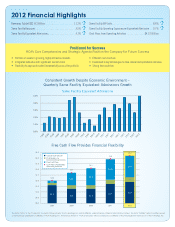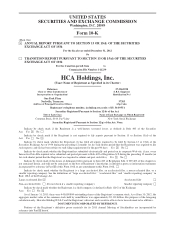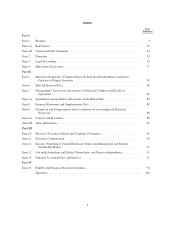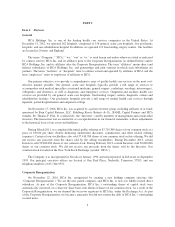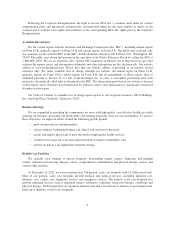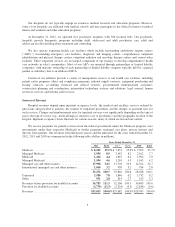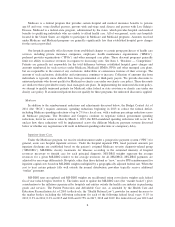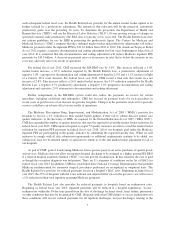HCA Holdings 2012 Annual Report Download - page 14
Download and view the complete annual report
Please find page 14 of the 2012 HCA Holdings annual report below. You can navigate through the pages in the report by either clicking on the pages listed below, or by using the keyword search tool below to find specific information within the annual report.
productivity gains over the preceding 10 years. To determine the projection, HHS will use the BLS 10-year
moving average of changes in specified economy-wide productivity. The Health Reform Law does not contain
guidelines for use by HHS in projecting the productivity figure. However, CMS estimates that the combined
market basket and productivity adjustments will reduce Medicare payments under the IPF PPS by $4.3 billion
from 2010 to 2019. For rate year 2012, which spanned 15 months from July 1, 2011 through September 30, 2012,
CMS increased inpatient psychiatric payment rates by 2.95%, which included a market basket increase of 3.2%
and a 0.25% reduction required by the Health Reform Law. For rate year 2013, which will follow the federal
fiscal year update cycle, CMS increased inpatient psychiatric payment rates by 1.9%, including a market basket
increase of 2.7%, reduced by a 0.7% productivity adjustment and a reduction of 0.1% as required by the Health
Reform Law. Beginning in federal fiscal year 2014, inpatient psychiatric facilities will be required to report
quality measures to CMS or will receive a 2.0% reduction to the market basket update. As of December 31, 2012,
we had five psychiatric hospitals and 41 hospital psychiatric units.
Ambulatory Surgery Centers
CMS reimburses ASCs using a predetermined fee schedule. Reimbursements for ASC overhead costs are
limited to no more than the overhead costs paid to hospital outpatient departments under the Medicare hospital
outpatient PPS for the same procedure. If CMS determines that a procedure is commonly performed in a
physician’s office, the ASC reimbursement for that procedure is limited to the reimbursement allowable under
the Medicare Part B Physician Fee Schedule, with limited exceptions. All surgical procedures, other than those
that pose a significant safety risk or generally require an overnight stay, are payable as ASC procedures. From
time to time, CMS considers expanding the services that may be performed in ASCs, which may result in more
Medicare procedures that historically have been performed in hospitals being moved to ASCs, reducing surgical
volume in our hospitals. Also, more Medicare procedures that historically have been performed in ASCs may be
moved to physicians’ offices. Commercial third-party payers may adopt similar policies. For federal fiscal year
2011 and each subsequent federal fiscal year, the Health Reform Law provides for the annual market basket
update to be reduced by a productivity adjustment. The amount of that reduction will be the projected nationwide
productivity gains over the preceding 10 years. To determine the projection, HHS will use the BLS 10-year
moving average of changes in specified economy-wide productivity. The Health Reform Law also required HHS
to submit a report to Congress on plans for developing a value-based purchasing program for ASCs. In its report,
HHS recommends a phased-in approach for implementing a value-based purchasing program but states
additional statutory authority would be required to allow performance-based payments. For calendar year 2013,
CMS has issued a final rule that provides for a 0.6% annual update to ASC payments, which includes the market
basket update of 1.4% and a negative 0.8% productivity adjustment. In addition, CMS has also established a
quality reporting program for ASCs under which ASCs that fail to report on five quality measures beginning on
October 1, 2012 will receive a 2% reduction in reimbursement for calendar year 2014.
Physician Services
Physician services are reimbursed under the physician fee schedule (“PFS”) system, under which CMS has
assigned a national relative value unit (“RVU”) to most medical procedures and services that reflects the various
resources required by a physician to provide the services relative to all other services. Each RVU is calculated
based on a combination of work required in terms of time and intensity of effort for the service, practice expense
(overhead) attributable to the service and malpractice insurance expense attributable to the service. These three
elements are each modified by a geographic adjustment factor to account for local practice costs and are then
aggregated. The aggregated amount is multiplied by a conversion factor that accounts for inflation and targeted
growth in Medicare expenditures (as calculated by the sustainable growth rate (“SGR”)) to arrive at the payment
amount for each service. While RVUs for various services may change in a given year, any alterations are
required by statute to be virtually budget neutral, such that total payments made under the PFS may not differ by
more than $20 million from what payments would have been if adjustments were not made.
The PFS rates are adjusted each year, and reductions in both current and future payments are anticipated.
The SGR formula, if implemented as mandated by statute, would result in significant reductions to payments
10


